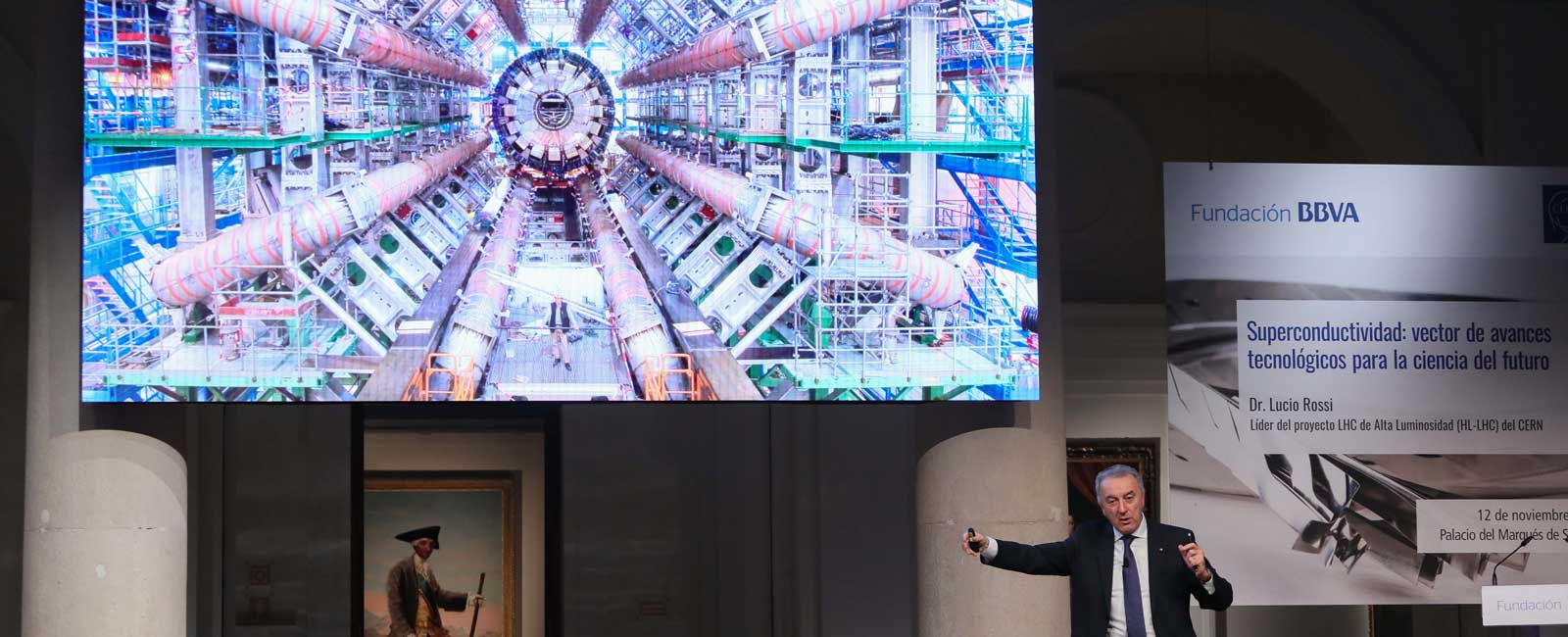From particle accelerators to disease diagnosis: the scientific and technological promise of superconductivity
Lucio Rossi is head of the High Luminosity project that will lend ten times more power to the large hadron collider (LHC) at CERN, the particle accelerator which gave the world the Higgs boson. His was the third and last talk in the 4th lecture series organized by CERN and the BBVA Foundation under the title Challenges in Particle Physics: The Technological, Globalized Dimension of Science.
20 November, 2018
Superconductivity is the amazing characteristic of some materials: when brought down to a very low temperature (around -270 °C), their electrical resistance disappears, enabling them to carry enormous currents without energy dissipation. Superconductor-based cables carry large currents in high magnetic fields, making possible the powerful electromagnets used in large particle accelerators, like the 27 km-long large hadron collider in Geneva, where the Higgs boson was detected.
At the same time superconductivity is also entering our daily lives. Thousands of hospitals and diagnostic centers around the world use large superconducting magnets for MRI (magnetic resonance imaging), and superconductivity is a key vector of technology innovation for a series of other cutting-edge applications. These topics were at the center of the talk given by Lucio Rossi, High Luminosity LHC (HL-LHC) Project Leader, as part of the 4th lecture series organized by CERN and the BBVA Foundation with the title Challenges in Particle Physics: The Technological, Globalized Dimension of Science.
From 1990 to 1998, Rossi was responsible for the first LHC dipole magnet prototypes for CERN and later for the first large superconducting toroidal coils for the ATLAS experiment at the LHC. In 2001 he joined CERN to lead the construction of magnets and superconductors for the LHC Project, and since 2010 has been High Luminosity LHC (HL-LHC) Project Leader. This is an international project working on the development of new leading-edge technologies, like 11-12 tesla novel superconducting magnets, in a bid to secure a five-fold increase in LHC luminosity by the year 2025.
“Superconductivity,” Rossi explains, “is the key technology underpinning the LHC. Thanks to superconductivity, the magnets that keep the protons (the accelerated particles) in orbit are five times more powerful than if they had been built with conventional technology, providing the beam energies needed to detect the Higgs boson.” In sum, the legendary particle that gives matter its mass, predicted by Peter Higgs in 1964, could not have been found without superconductivity.
Rossi also sees this technology as vital going forward if the goal is to get beyond the Standard Model of Physics. “With the High Luminosity LHC project, we intend to increase collisions ten times over, boosting the accelerator’s discovery reach.” Indeed Rossi believes it should be possible to achieve a more precise understanding of the properties of the Higgs boson, and also to detect new particles. “All this will be crucial to determine the direction of future research projects in the particle physics field,” he affirms.
Besides its importance for basic science, Rossi points out that the superconductivity developed at CERN is being applied in other areas, especially medicine. “More than 90% of magnetic resonance imaging (MRI) relies on superconducting magnets. Worldwide about 2,000 superconductivity-based devices are installed every year. Further, the technology has found applications in pharmacology to enable the study and manufacture of new molecules.”
At the same time, the next generation of nuclear reactors, with less risk and impact, are based on huge superconducting magnets; and some pilot plants are already using superconducting cables for power transmission. Rossi is also confident that superconductivity could play a key part in producing clean energy from fusion, as pursued by the international ITER project. “Superconductivity,” he insists, “is a fascinating process that not only opens up new avenues of knowledge to answer fundamental questions about matter and the universe, but has also produced technological applications of great benefit to humanity, and will continue to do so in future.”
CERN and the BBVA Foundation
The collaboration between CERN and the BBVA Foundation dates from 2014, when the supranational organization opted to celebrate its 60th anniversary in Spain in partnership with the Foundation. The result was the lecture series “The Secrets of Particles. Fundamental Physics in Everyday Life” whose closing speaker was CERN’s outgoing Director-General, Rolf Heuer. This was followed by a second edition where speakers included Heuer’s successor, Fabiola Gianotti. All lectures in the three series are available in full on the website www.fbbva.es and the playlists of our Youtube channel.

